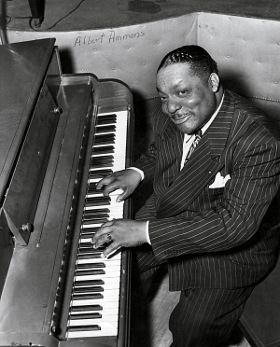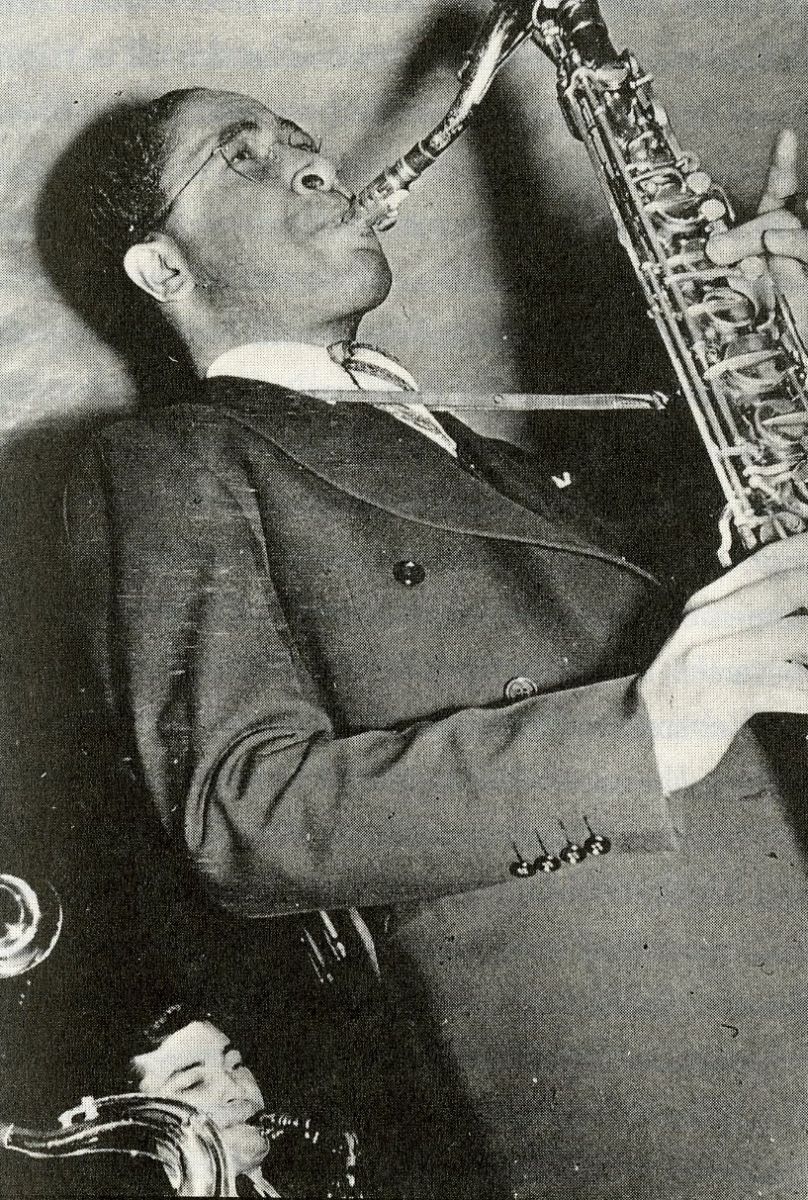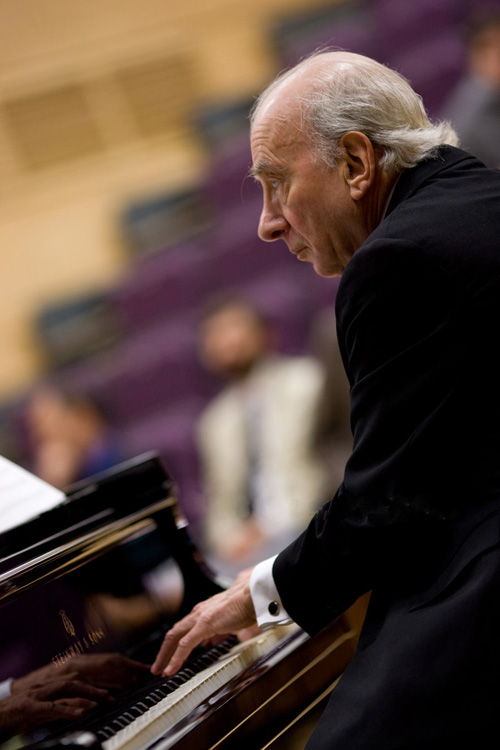
Jay McShann. Photo courtesy of The Landing.
In the late 1930s about the time the original Swing dance craze hit the nation, another kind of dance music began to find a national audience. Around the turn of the 20th century, long before it became a popular dance craze, Boogie Woogie came stomping out of the rural Deep South, out of logging camps in East Texas and Louisiana. It converged in Chicago in the early 20s just as the first jazz bands gained traction there. Boogie Woogie was a staple at rent parties on Chicago’s South Side, or “buffet flats” as they were known in Kansas City. Early star Boogie Woogie piano players—like Jimmy Yancey and Cow Cow Davenport—came out of the vaudeville circuit where they were booked by the notorious TOBA or Theater Owners Booking Agency. No one called the music style “Boogie Woogie” back then, it was just good time party music.
Boogie Woogie. The name itself sounds funky. The unmistakable beat brings to mind stories of honky tonks and juke joints. Boogie Woogie is as American as apple pie—it’s twelve bar blues with attitude. So, don’t be shy—you won’t be able to sit still. It’s a Boogie Woogie and Blues celebration on our Riverwalk Jazz radio dance party. Piano giants Dick Hyman and Jay McShann join The Jim Cullum Jazz Band with music of Jelly Roll Morton, Jimmy Yancey, Pine Top Smith, and more.
Playlist notes on this week’s show:

Albert Ammons. Photo in public domain.
Albert Ammons recorded “Jammin’ the Boogie“ in 1944 at the height of the Boogie Woogie craze. Our version showcases Dick Hyman and John Sheridan on two grand pianos with The Jim Cullum Jazz Band.
“Yancey Special,” composed by Jimmy Yancey, one of the earliest of the great Boogie Woogie players, demonstrates a left hand bass line that was a trademark of Yancey’s style.
“Honky Tonk Music,“ composed early in Jelly Roll Morton’s career, is one of a handful of Morton tunes with elements reflecting a distinct Boogie Woogie flavor, and other sections reminiscent of the Tango—another key element of Morton’s style.
Clarence “Pine Top” Smith’s 1928 tune "Pine Top's Boogie Woogie,” the first record in history to be labeled with a Boogie Woogie moniker, had great influence on subsequent Boogie Woogie stylings. Throughout the 1920s, Smith toured on the TOBA vaudeville circuit, often performing with blues singer Mamie Smith and the comedy duo Butter Beans and Susie. Pine Top met a fatal accident in a 1929 shootout at a Chicago dance hall.

Herschel Evans. Photo courtesy of Denton Public Library.
Kansas City was the home of the blues in the 1930s. It was a crossroads where Boogie Woogie and blues blended with Swing to produce what came to be known as the “Kansas City sound.” It’s the emblematic sound of the storied Count Basie Band rhythm section, of blues “shouter” Jimmy Rushing, and the urgent tenor saxophone of Herschel Evans. On this broadcast, Jim Cullum Jazz Band reedman Brian Ogilvie is showcased on a 1938 Basie standard “Doggin' Around,“ backed by the band’s rhythm section, and offering a combination of swing rhythm with a bluesy saxophone sound reminiscent of Evans.
In 1941 “Confessin' the Blues“ topped the charts for Kansas City bluesman Jay McShann and his band with a smash hit record on the Decca label. On this show, Jay tells the story of how the recording session happened to take place in Dallas, Texas under the direction of Decca producer Dave Kapp with McShann’s band and singer Walter Brown.
Another feature of the Kansas City sound was the “blues shouter,” a style developed in the days before microphones by singers who had to belt out their songs to be heard above the roar of the band.
.jpg)
Joe Williams. Photo courtesy lastfm.
Jimmy Rushing, known as “Mr. Five by Five” was the king of the Kansas City Blues shouters. His theme song with the Count Basie band was “Ev’ry Day I Have the Blues.“ Rushing never had a hit record with it, but later it clicked in Chicago for another Basie Band vocalist, the great Joe Williams, who performs this tune—that launched his career—with The Jim Cullum Jazz Band on stage at The Landing in San Antonio.
In 1937 Benny Goodman asked Kansas City pianist and composer Mary Lou Williams to write a song for his band. The result—“Roll 'Em”—helped launch the nationwide Boogie Woogie craze of the late 30s and gave the Goodman Orchestra a huge hit.
“A-flat Dream“ is unusual as it is one of only a few pieces in the output of the brilliant early jazz piano master James P. Johnson making use of the rhythm and texture of Boogie Woogie.

Dick Hyman. Photo courtesy of the artist.
George Gershwin loved the Boogie Woogie beat. To entertain friends at parties at his Riverside Drive apartment in Manhattan, Gershwin would often play show tunes he wrote for the Broadway stage in a Boogie Woogie style. Here, our piano duo, Dick Hyman and John Sheridan, join The Jim Cullum Jazz Band to perform a Boogie Woogie-flavored version of “I'll Build a Stairway to Paradise,“ a tune Gershwin originally composed for the stage show George White's Scandals of 1922.
“Solid Gate Boogie“ is an improvised collaboration of riffs and blues melodies cooked up on the spot for this broadcast by Jim Cullum, Dick Hyman and the band members.
In 1939 Earl “Fatha” Hines tapped into Boogie Woogie fever when he took W.C. Handy’s classic blues tune “St. Louis Blues“ and turned it into a Boogie Woogie number, now known as “Boogie Woogie on The St. Louis Blues.”
The sizzling up-tempo “K.K. Boogie,“ heard under our credit roll this week, is Henry “Red” Allen’s tribute to Ken Kersey, one of the last of the Boogie Woogie masters.
Photo credit for Home Page: Jay McShann. Photo courtesy of The Landing.
Text based on Riverwalk Jazz script by Margaret Moos Pick ©1999

